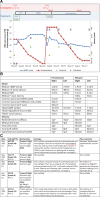Diagnostic delay in a case of T-cell neurolymphomatosis
- PMID: 31888900
- PMCID: PMC6936382
- DOI: 10.1136/bcr-2019-232538
Diagnostic delay in a case of T-cell neurolymphomatosis
Abstract
A 69-year-old woman presented with severe subacute painful meningoradiculoneuritis. Neurophysiology showed a patchy, proximal axonal process with widespread denervation. Cerebrospinal fluid (CSF) was lymphocytic (normal T-cell predominant) with negative cytology. MRI revealed multiple sites of enhancement, but fluorodeoxyglucose positron emission tomography was negative. Bone marrow aspirate and trephine (BMAT) showed no evidence of a lymphoproliferative condition. Right brachial plexus biopsy demonstrated mixed T-cell/B-cell endoneurial inflammation not fulfilling criteria for vasculitis. She was stabilised with high-dose steroids and cyclophosphamide, followed by mycophenolate for inflammatory myeloradiculoneuritis. However, symptoms recurred when prednisolone was weaned. Although T-cell receptor gene analysis from the initial CSF demonstrated clonal rearrangements, it was only when the same clones were identified on two repeat BMATs and CSF that T-cell neurolymphomatosis, an exceedingly rare condition, was diagnosed. This case highlights the diagnostic challenge in peripheral neurolymphomatosis related to patchy disease, variable sensitivity and specificity of investigative tools, and the influence of therapies on traditional cytological definitions of lymphoma. The clinical picture, exhaustive exclusion of alternative causes and the persistence of an abnormal T-cell clone ultimately lead to a diagnostic consensus between specialist neurology and haematology clinicians.
Keywords: haematology (incl blood transfusion); neuromuscular disease; peripheral nerve disease.
© BMJ Publishing Group Limited 2019. No commercial re-use. See rights and permissions. Published by BMJ.
Conflict of interest statement
Competing interests: None declared.
Figures


References
Publication types
MeSH terms
Substances
LinkOut - more resources
Full Text Sources
